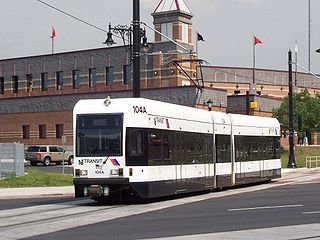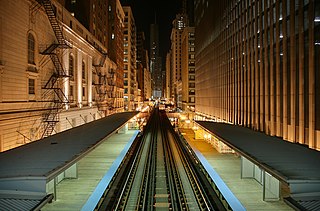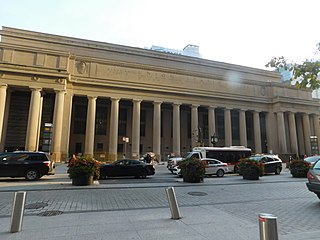
A tram is a train that runs on a tramway track on public urban streets; some include segments on segregated right-of-way. The lines or networks operated by tramcars as public transport are called tramways or simply tram/streetcar. Many recently built tramways use the contemporary term light rail. The vehicles are called streetcars or trolleys in North America and trams or tramcars elsewhere. The first two terms are often used interchangeably in the United States, with trolley being the preferred term in the eastern US and streetcar in the western US. Streetcar or tramway are preferred in Canada. In parts of the United States, internally powered buses made to resemble a streetcar are often referred to as "trolleys". To avoid further confusion with trolley buses, the American Public Transportation Association (APTA) refers to them as "trolley-replica buses". In the United States, the term tram has sometimes been used for rubber-tired trackless trains, which are unrelated to other kinds of trams.

The Toronto Transit Commission (TTC) is the public transport agency that operates bus, subway, streetcar, and paratransit services in Toronto, Ontario, Canada, some of which run into the Peel Region and York Region. It is the oldest and largest of the urban transit service providers in the Greater Toronto Area, with numerous connections to systems serving its surrounding municipalities.

Light rail transit (LRT) is a form of passenger urban rail transit characterized by a combination of tram and metro features. While its rolling stock is more similar to a traditional tram, it operates at a higher capacity and speed, and often on an exclusive right-of-way. In many cities, light rail transit systems more closely resemble, and are therefore indistinguishable from, traditional underground or at-grade subways and heavy-rail metros.

The Newark Light Rail (NLR) is a light rail system serving Newark, New Jersey and surrounding areas, operated by New Jersey Transit Bus Operations. The service consists of two segments, the original Newark City Subway (NCS), and the extension to Broad Street station. The City Subway opened on May 16, 1935, while the combined Newark Light Rail service was officially inaugurated on July 17, 2006.

The Toronto subway is a rapid transit system serving Toronto and the neighbouring city of Vaughan in Ontario, Canada, operated by the Toronto Transit Commission (TTC). It is a multimodal rail network consisting of three heavy-capacity rail lines operating predominantly underground, and one elevated medium-capacity rail line. Two light rail lines and one light metro line are under construction.

Muni Metro is a hybrid light rail/streetcar system serving San Francisco, California, United States, operated by the San Francisco Municipal Railway (Muni), a division of the San Francisco Municipal Transportation Agency (SFMTA).

The J Church is a hybrid light rail/streetcar line of the Muni Metro system in San Francisco, California. The line runs between Embarcadero station and Balboa Park station through Noe Valley. Opened on August 11, 1917, it is the oldest of the currently running Muni Metro lines. The line has the lowest ridership of all of the Muni Metro lines.

The Toronto streetcar system is a network of nine streetcar routes in Toronto, Ontario, Canada, operated by the Toronto Transit Commission (TTC). It is the third busiest light-rail system in North America. The network is concentrated primarily in Downtown Toronto and in proximity to the city's waterfront. Much of the streetcar route network dates from the 19th century. Most of Toronto's streetcar routes operate on street trackage shared with vehicular traffic, and streetcars stop on demand at frequent stops like buses.

Urban rail transit is an all-encompassing term for various types of local rail systems providing passenger service within and around urban or suburban areas. The set of urban rail systems can be roughly subdivided into the following categories, which sometimes overlap because some systems or lines have aspects of multiple types.
Various terms are used for passenger railway lines and equipment; the usage of these terms differs substantially between areas:

The 512 St. Clair is an east–west streetcar route in Toronto, Ontario, Canada, operated by the Toronto Transit Commission (TTC). It operates on St. Clair Avenue between St. Clair station on the Line 1 Yonge–University subway and Gunns Road, just west of Keele Street.

Light RailLink is a light rail system serving Baltimore, Maryland, United States, as well as its surrounding suburbs. It is operated by the Maryland Transit Administration. In downtown Baltimore, it uses city streets. Outside the central portions of the city, the line is built on private rights-of-way, mostly from the defunct Northern Central Railway, Baltimore and Annapolis Railroad and Washington, Baltimore and Annapolis Electric Railway.

Light rail is a commonly used mode of public transit in North America. The term light rail was coined in 1972 by the Urban Mass Transportation Administration to describe new streetcar transformations which were taking place in Europe and the United States. The Germans used the term Stadtbahn, which is the predecessor to North American light rail, to describe the concept, and many in UMTA wanted to adopt the direct translation, which is city rail. However, in its reports, UMTA finally adopted the term light rail instead.

The Pittsburgh Light Rail is a 26.2-mile (42.2 km) light rail system in Pittsburgh, Pennsylvania, and surrounding suburbs. It operates as a deep-level subway in Downtown Pittsburgh, but runs mostly at-grade in the suburbs south of the city. The system is largely linear in a north-south direction, with one terminus just north of Pittsburgh's central business district and two termini in the South Hills. The system is owned and operated by the Port Authority of Allegheny County. It is the successor system to the streetcar network formerly operated by Pittsburgh Railways, the oldest portions of which date to 1903. The Pittsburgh light rail lines are vestigial from the city's streetcar days, and is one of only three light rail systems in the United States that continues to use the Pennsylvania Trolley (broad) gauge rail on its lines instead of 4 ft 8+1⁄2 instandard gauge. Pittsburgh is one of the few North American cities that have continued to operate light rail systems in an uninterrupted evolution from the first-generation streetcar era, along with Boston, Cleveland, New Orleans, Newark, Philadelphia, San Francisco and Toronto.
Accessibility for people with disabilities on the Toronto Transit Commission (TTC) system is incomplete but improving. Most of the Toronto subway system was built before wheelchair access was a requirement under the Ontarians with Disabilities Act (ODA). However, all subway stations built since 1996 are equipped with elevators, and elevators have been installed in 44 stations built before 1996. Over seventy percent of Toronto's subway stations are accessible. In 2014, the TTC began introducing new low-floor vehicles on its streetcar network. These accessible vehicles ultimately replaced the ageing, non-accessible Canadian and Articulated Light Rail Vehicle streetcars by December 29, 2019. In December 2015, the TTC retired the last of its lift-equipped high-floor buses, which were introduced in 1996, making all TTC bus routes 100% low-floor accessible.

A rail replacement bus service uses buses to replace a passenger train service either on a temporary or permanent basis. The train service that is replaced may be of any type such as light rail, tram, streetcar, commuter rail, regional rail or heavy rail, intercity passenger service. The rail service may be replaced if the line is closed due to rail maintenance, a breakdown of a train, a rail accident, strike action or to simply provide additional capacity, or if the rail service is not economically viable.

Although tram systems date to the late 19th and early 20th centuries, many old systems were closed during the mid-20th century because of the advent of automobile travel. This was especially the case in North America, but postwar reductions and shutdowns also occurred on British, French and other Western European urban rail networks. However, traditional tramway systems survived, and eventually even began to thrive from the late 20th century onward, some eventually operating as much as when they were first built over a century ago. Their numbers have been augmented by modern tramway or light rail systems in cities which had discarded this form of transport.

High-floor describes the interior flooring of commuter vehicles primarily used in public transport such as trains, light rail cars and other rail vehicles, along with buses and trolleybuses. Interior floor height is generally measured above the street surface or above the top of the rail. High-floor designs usually result from packaging requirements: mechanical items such as axles, motors, crankshafts, and/or transmissions, or luggage storage spaces are traditionally placed under the interior floor of these vehicles. The term is used in contrast with low-floor designs, which offer a decreased floor and entry height above the street surface. Since low-floor designs generally were developed after high-floor vehicles, the older high-floor design is sometimes also known as conventional or the “traditional” design.

Public transportation in Toronto dates back to 1849 with the creation of a horse-drawn stagecoach company. Today, Toronto's mass transit is primarily made up of a system of subways, buses, and streetcars, covering approximately 1,200 km (750 mi) of routes operated by the Toronto Transit Commission (TTC) and inter-regional commuter rail and bus service is provided by GO Transit.

Toronto-gauge railways are tram and rapid transit lines built to Toronto gauge, a broad gauge of 4 ft 10+7⁄8 in. This is 2+3⁄8 in (60 mm) wider than standard gauge of 4 ft 8+1⁄2 in which is by far the most common track gauge in Canada. The gauge is unique to the Greater Toronto Area and is currently used on the Toronto streetcar system and the Toronto subway, both operated by the Toronto Transit Commission. As well, the Halton County Radial Railway, a transport museum, uses the Toronto gauge so its rail line can accommodate its collection of Toronto streetcars and subway trains. Several now-defunct interurban rail systems also once used this gauge.





















